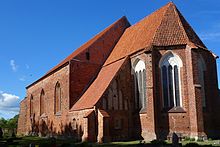Village church hall
The village church hall is from the 13th / 14th centuries. Century village church in the Western Pomeranian community of Saal . It is recognized in art historical literature as "excellent evidence of the high quality of construction in the early days of the north German brick Gothic ".
history
The oldest part of the church is the choir , built in 1285 (d) according to recent dendrochronological studies , which later received chapels on both sides. The nave was built at the beginning of the 14th century. The free-standing, wooden bell tower was built in 1475 (d). It is unique in its form.
reception
According to a legend, a secret, underground passage behind the altar leads to the bay . According to another legend, under the bell tower there is a cavity in which, before 1300, part of the Templar treasure that one of the Templars had stolen was hidden. It is said to be about the missing imperial insignia of Johann Ohneland , which he lost in an unclear way in 1216.
architecture
The entire structure is made of brick , the walls have a field stone base. The choir ends in a five-eighth closure and shows tracery windows with three-passes, the 17th / 18th centuries. Century were partially added with stucco. The vestibule adjoining the choir to the north and the sacristy on the south side are designed with glare windows on the east gables. The walls of the nave are divided by three large windows and a portal. The walls of the portals are richly profiled, the southern one is walled up.
The massive west wall has four stepped buttresses . The tower was originally supposed to be placed in front of the wall, but for unknown reasons - it could have been an unsafe building site or lack of money - it was carried out as a separate construction. All walls have scaffolding holes dating back to the construction period as well as defects in the masonry that indicate former extensions and modifications. The eastern pair of pillars is eight-sided, the western one was made stronger to accommodate a tower that was not built. Decorative architectural painting from the beginning of the 14th century can be found on the northeast pillar.
The wooden bell tower stands northeast next to the church. Inside there are two bells by Gottlieb Metzger and Simon Zach (1798 and 1820, respectively), both from Stralsund , as well as an iron tower clock mechanism with walking and striking mechanism from around 1730, the associated dial was removed a long time ago.
Furnishing
The most important parts of the furnishings belong to the Baroque style . The altarpiece and the pulpit were created by Dittrich Hartig from Rostock in the early 18th century. The altarpiece has an architectural structure with twisted columns and is decorated with large figures of Aaron and Moses on the side, the crowning with the Salvator and John the Baptist. The pulpit is carried by a trumpet angel, on the basket are reliefs of adoration, baptism and crucifixion, on the sound cover the risen Christ with a strut crown. The baptismal font, made of limestone, from the dome of which the edge was chipped off at an unknown time, dates from the 13th century. The equipment includes the prayer chair of the von Gentzkow and von Ihlenfeld families on Schlechtmühl (today Hessenburg ). Six cabinet disks with name inscriptions show, among other things, the spitting out of Jonah, Simon's fight with the lion and coat of arms and are partly dated to 1724.
organ
The organ was built in 1780 by Christian Heinrich Kersten . Modifications were made in 1834 by Carl August Buchholz and in 1904 by Barnim Grüneberg . In 2004 the organ was restored by Hans van Rossum and today it has 15 stops on two manuals and a pedal . The disposition is:
|
|
|
|||||||||||||||||||||||||||||||||||||||||
- Tremulant , Noli me tangere
local community
The parish has been part of the Stralsund Propstei in the Pomeranian Evangelical Church District of the Evangelical Lutheran Church in Northern Germany since 2012 . Before that she belonged to the Stralsund parish of the Pomeranian Evangelical Church .
Web links
- Literature about the village church hall in the state bibliography MV
- Evangelical Lutheran Church in Northern Germany
Individual evidence
- ↑ a b c Georg Dehio : Handbook of German Art Monuments. Mecklenburg-Western Pomerania. 2nd Edition. Deutscher Kunstverlag, Berlin / Munich 2016, ISBN 978-3-422-03128-9 , p. 543.
- ↑ Information about the organ on orgbase.nl. Retrieved May 23, 2020 .
Coordinates: 54 ° 18 ′ 33.8 " N , 12 ° 29 ′ 45.8" E




